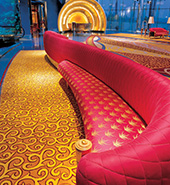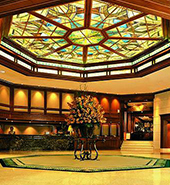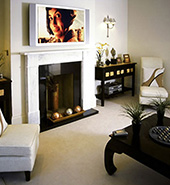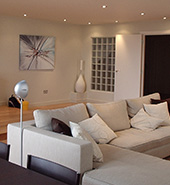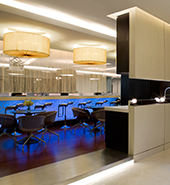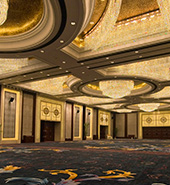Glossary
Glossary of lighting industry terminology
A glossary of terms used in the lighting industry and on futronix.com
Channel:
Each circuit connected to a dimmer is connected via a channel. The terms channel and circuit are closely related. The maximum number of circuits that can be connected to the dimmer is equal to the number of channels.
Load per Circuit:
The maximum total load allowed for the dimmer is less than or equal to the sum of the maximum loads for each circuit.
There is no minimum load on any circuit.
Dimensions:
For dimmers that fit into the wall, remember that the dimensions of the external switch plate are slightly larger than than the dimensions of the dimmer.
Difference between plain switches and switch panels:
A plain switch has only two possiblities: on and off.
With dimming switch panels:
- Intensity of the light can be varied.
- The rate at which the light turns on/off can be controlled.
- You can create scenes.
- You can dim or fade into any scene and the rate can be varied.
- Your favourite settings are stored.
- Dimming prolongs bulb life.
- Dimming saves electric power.
Fade-In/Fade-Out:
Do you want the lights to come on instantly or would you prefer that they gradually get brighter as time goes on?
As the evening draws on would you like the lights to gradually fade?
Futronix Dimmers allow you to control how quickly these events occur. The minimum is .5 secs. Fading also increases bulb life by around 30% because turning on the light gradually is gentler on the filament.
LED Display:
The Futronix P100, P400 and P800 have a built-in LED display to allow you to select scenes and to program the dimmer.
Light Bulb Types
Some types of lightbulbs cannot be dimmed and can only be on switched either on or off. Some types can be dimmed by the Futronix commercial dimming system.
Type |
Symbol |
Dimming Capabilities |
Halogen |
Dimming and Switching | |
Low-Voltage |
Dimming and Switching | |
Tungsten |
Dimming and Switching | |
Fluorescent |
Switching* | |
Pl-Fluorescent |
Switching* | |
Compact Fluorescent |
Switching only (No Dimming) | |
| *Dimming is available with the Futronix Enviroscene or PFX dimming systems. | ||
Outstations (Remote Switching Panels):
Imagine a room with two entrances. It would be convenient to control the room’s lighting with two switches, one next to each door.
An outstation is a switch panel that also controls a dimmer but is located in a different part of the room from the dimmer itself.
This gives you a choice of controlling the circuit either directly from the dimmer switch panel or remotely from this other switch (which is referred to as an outstation).
The P800 domestic dimmer and the Futronix Enviroscene and PFX commercial dimming systems feature outstations.
Remote Control:
Would you like to instantly dim the lights from the comfort of your lounge chair? A Futronix remote control is provided as standard.
Scene Dimming:
All Futronix dimming products feature scene dimming.
With scene dimming you give a room an individual look. This look comes from setting the brightness of the lights on different circuits. A group of circuits for which you adjust brightness forms a zone.
The P800 domestic dimmer, Futronix Enviroscene and PFX commercial dimming systems feature multiple zones. The P100 and P400 dimmers have only one zone.
One set of lighting levels constitutes a ‘scene’. Most Futronix products have up to 20 scenes (per zone).
Combine brightness and colored lights to produce some stunning effects.
Security Settings:
If your property is not occupied and you want the lights to change at various times to create the impression someone is in, security settings are the answer.
A security setting can be set to automatically sequence through the scenes, holding each one for a variable length of time. The sequence can last from several minutes to hours.
For the Futronix P800 domestic dimmer optional outstations are available, allowing operation from remote locations.
Timer:
A timer allows you to select any scene to appear at any time of the day or week. Up to 70 of these events can be programmed for the week (10 per day).
The uses range from turning the lights on when you come home to gradually waking you up in the morning.
All of the Futronix P100, P400 and P800 Residential Dimmers feature timers.
Total Load for dimmer:
The maximum total load allowed for the dimmer is less than or equal to the sum of the maximun loads for each circuit.
Wallbox:
The Futronix P100 dimmer fits a standard UK wallbox used for a normal light switch. The P400 and P800 are larger and need special wallboxes which are provided.
Why Digital Dimmers?
Futronix products ride the wave of technological development. Futronix dimmers are all-digital, meaning that all functionality is microprocessor controlled.
Digital dimming has these advantages:
- Reliability
- Compact design
- Precise control of lighting levels
- Programmability
- Versatility
Why Dimming?:
Dimming has these advantages:
- Intensity of the light can be varied
- The rate at which the light turns on/off can be controlled.
- Your favourite settings are stored.
- You can dim or fade into any scene and the rate can be varied.
- Dimming prolongs bulb life.
- Dimming saves electric power.
Dimming saves power by giving the user convenient control over the level of lighting. The user is no longer confined to using the one level of power and now has a choice:
| Light Level | Electricity Saved | Extends Bulb Life |
| 90% | 10% | 2x |
| 75% | 20% | 4x |
| 50% | 40% | 20x |
| 25% | 60% | > 20x |
Zone:
Circuits can be grouped together as zones. Usually a zone corresponds to a single room, but it doesn’t have to. The user of the dimming system decides what circuit belongs to what zone.
Scenes are created on a per zone basis. To ‘set’ scene you programme things such as:
- lighting levels
- fade rates.


